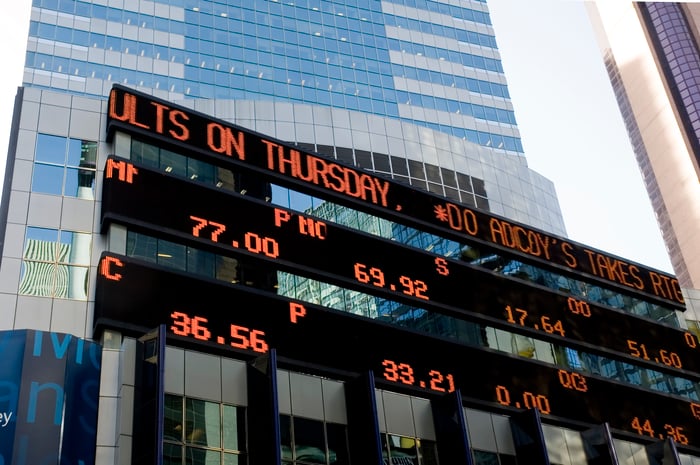For more than 127 years, the iconic Dow Jones Industrial Average (^DJI 0.40%) has served as the most-watched barometer of Wall Street's health.
At its inception in 1896, the Dow contained 12 stocks that were predominantly from the industrial sector. But after more than 50 changes to the highly watched index, the Dow Jones is now composed of 30 historically profitable, time-tested, multinational businesses.
However, the outlooks for these 30 Dow components differ greatly. While some stand out as truly phenomenal values, others have separated themselves for all the wrong reasons. As we motor forward in November, two of these magnificent Dow stocks are ripe for the picking, while another is best left on the shelf.

Image source: Getty Images.
Magnificent Dow stock No. 1 to buy in November: Johnson & Johnson
The first superb Dow Jones stock that's worthy of being added to investors' portfolios in November is none other than healthcare conglomerate Johnson & Johnson (JNJ -0.46%), which is more commonly known as "J&J."
J&J is contending with two headwinds, which recently pushed shares to their lowest point in three years. The first is the unknown financial overhang associated with approximately 100,000 lawsuits that allege its now-discontinued talcum-based baby powder causes cancer. While J&J hasn't admitted any guilt, it has attempted to resolve these suits with a settlement of as much as $8.9 billion. Both attempts by J&J to put these claims in the rearview mirror were dismissed in court.
The other concern for J&J is that more than half of its net sales now derive from pharmaceuticals. Since brand-name therapies have finite periods of sales exclusivity, skeptics believe J&J could struggle to grow its sales and profits as the patent cliff hits.
While these headwinds shouldn't be ignored, they're not nearly as concerning as they might sound on paper. For instance, Johnson & Johnson is one of only two publicly traded companies that's received the highest possible credit rating (AAA) from Standard & Poor's (S&P), a division of the more-familiar S&P Global. J&J's steady operating cash flow and healthy balance sheet gives S&P the utmost confidence that it can service and repay its debts, as well as deal with whatever settlement may lie ahead.
Furthermore, Johnson & Johnson has been aggressively reinvesting in its drug-development pipeline. The company's internal innovation, multiple collaborations, and ability to make the occasional acquisition should allow it to easily weather future losses of exclusivity on brand-name drugs.
Another oft-overlooked reason why J&J is such a superstar is its leadership continuity. You'll only need two hands to count the number of CEOs Johnson & Johnson has had since its founding in 1886. This lack of turnover ensures that strategic initiatives are being properly implemented, which has helped to fuel 61 consecutive years of dividend increases for shareholders.
The cherry on top for prospective investors is that Johnson & Johnson is historically cheap. The company's forward price-to-earnings (P/E) ratio of 14 is lower than it's been at any point over the past decade.
Magnificent Dow stock No. 2 to buy in November: Walgreens Boots Alliance
A second magnificent Dow stock that's ripe for the picking in November is pharmacy chain Walgreens Boots Alliance (WBA 0.57%).
Walgreens has been contending with a number of clear-cut headwinds that include online retailers (e.g., Amazon) entering the pharmacy space, as well as COVID-19-related sales declining with the worst of the pandemic in the rearview mirror. Fewer people visiting its stores for COVID-19 testing kits and vaccines has weighed on the company's sales.
But a strong case can be made that all of the bad news surrounding Walgreens Boots Alliance has been fully baked in at this point.
The company's management team has a multipoint turnaround strategy already in motion. After lopping off more than $2 billion from its annual expenses, the plan is for Walgreens to now target $4.1 billion in cumulative yearly cost reductions. While cost-cutting is a positive for the company's operating margin, it's by no means a cure-all.
In terms of growth, the most exciting development for Walgreens is its vertical shift into healthcare services. It's become a majority owner in health-clinic operator VillageMD, with the duo opening more than 200 stores co-located at Walgreens' locations in select major U.S. markets. What differentiates these health clinics is that they're full-service and physician-staffed. Being able to handle more than just a sniffle or a vaccine should lead to repeat visits and improve customer loyalty at the grassroots level.
Walgreens' hire of Tim Wentworth as its next CEO also shows it's serious about getting back to its roots. Unlike now-former CEO Rosalind Brewer, Wentworth has an extensive background in healthcare. This makes it likelier that Wentworth will have a deeper understanding of how to steer Walgreens through a challenging environment.
Lastly, the valuation is highly compelling for long-term investors. Walgreens stock can be scooped up for just 6 times forward-year earnings. Though it's unclear if Walgreens will sustain its existing payout, it's also currently yielding nearly 9%!

Image source: Getty Images.
The Dow stock to avoid like the plague in November: Procter & Gamble
However, not all Dow stocks are necessarily good deals at the moment. The Dow component that's worth avoiding like the plague in November is consumer staples giant Procter & Gamble (PG -0.78%), which is often referred to as "P&G."
Let me state straight away that P&G isn't a bad company. It has exceptional pricing power, which comes with owning an assortment of very well-known brands, such as Tide, Bounty, Gillette, Dawn, and Crest, among others. When the U.S. inflation rate hit four-decade highs in 2022, Procter & Gamble had little issue passing along price hikes to shoppers.
Similar to J&J, Procter & Gamble has had long-tenured CEOs. The value of not having a carousel at key leadership positions can't be overstated. It's a big reason P&G has been such a steady wealth-creator for the company's long-term shareholders.
However, there are two meaningful headwinds that should keep prospective investors firmly on the sidelines.
The first issue is that we're seeing clear evidence of consumers resisting price hikes and/or trading down to cheaper store brands. Procter & Gamble's fiscal 2024 first-quarter report showed volume declines in its grooming, fabric and home care, and baby, feminine, and family care segments. Over the past couple of quarters, the entirety of P&G's revenue growth has come from price increases. This is unlikely to be sustainable with volume declining.
The other worry for Procter & Gamble is the company's valuation. Historically, it's not unusual for P&G to command a P/E multiple north of 20 when the U.S. economy is firing on all cylinders. But it makes little sense for the company to trade at 22 times forward-year earnings when sales are expected to decline by a low-single-digit percentage in fiscal 2024 (P&G's fiscal year ends on June 30, 2024).
Procter & Gamble has a solid portfolio of brands and won't struggle to increase its dividend. But there are far better values among the Dow's 30 components than P&G in November.





